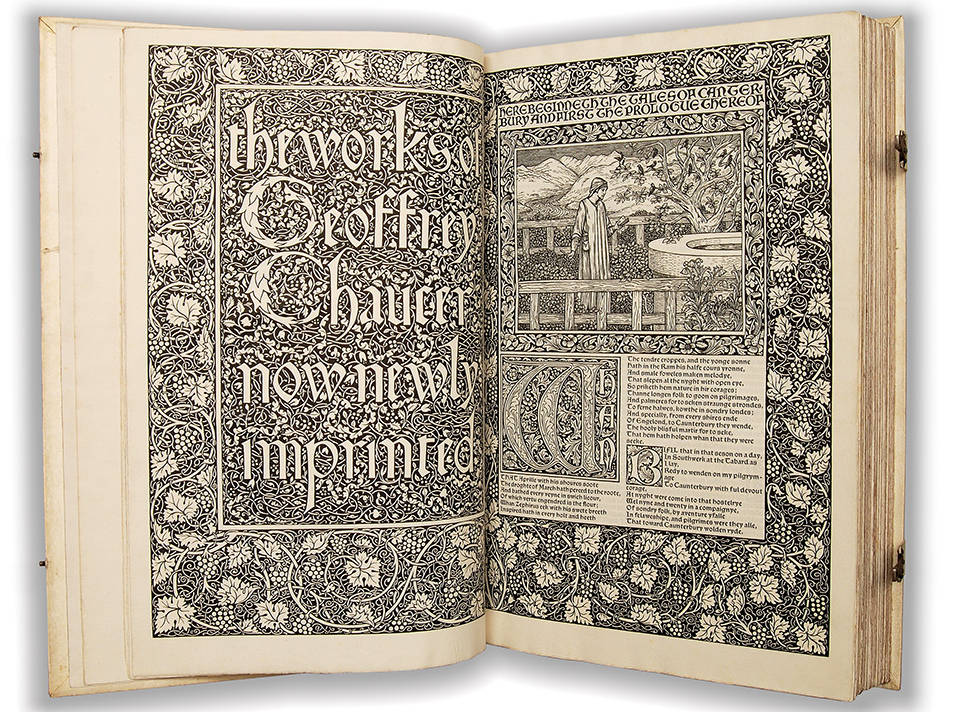
n an unfinished essay of the 1890s, William Morris wrote: ‘if I were asked to say what is at once the most important production of art and the thing to be most longed for, I should answer, a beautiful house; and if I were further asked to name the production next in importance and the thing next to be longed for, I should answer, a beautiful Book. to enjoy good houses and good books in self-respect and decent comfort, seems to me to be the pleasurable end towards which all societies of human beings ought now to struggle.’1 When he wrote that, he was evoking a will-o’-the-wisp he had been in pursuit of for most of his adult life and—almost too late—had at last succeeded in capturing.


Left to right: (a) A Note by William Morris on His Aims in Founding the Kelmscott Press (1898). (b) The Story of the Glittering Plain (1891). [Click on these images for larger pictures.]
In 1892 he had founded the Kelmscott Press, through which in the course of the next four years he published some sixty fine-press editions, culminating in the year of his death with the famous Kelmscott Chaucer, described by W. B. Yeats as ‘the most beautiful of all printed books’.2

[Click on image to enlarge it and for commentary by both Peter Harrington and Alice Beckwith]
The Kelmscott Press is universally acknowledged as the enterprise that launched and inspired the private-press movement, which became so important a force in the art of the twentieth century.
Because this last of Morris’s many endeavours was so successful, it tends to be forgotten that twenty years earlier he had made another attempt at creating the ideal book. Between 1869 and 1875 Morris ‘produced a group of eighteen illuminated books, over 1,500 pages of script and ornament in various stages of completion’.3 only two of these appear to be complete, though several others are very nearly so. Morris was seeking to revive the art of the illuminated manuscript, which in European culture is mostly associated with the middle ages and, in particular, with sacred texts. Though he worked with collaborators, he seems to have thought of the work as a hobby that satisfied certain needs in his personal life. Nevertheless, his work was serious and, with renaissance and Persian manuscripts— rather than medieval—as his models, he seems to have thought it possible to revive the art in a manner appropriate to the modern age.


An example of manuscript illumination by Morris and printed bood design in imitation of illuminated manuscripts: (a) Ogmund comes to Midfirth (1871). (b) Laudes Beatae Mariae Virginis (1896). [Click on these images for larger pictures.]
Though he must have been aware that the demise of the art by the end of the sixteenth century was largely due to the triumph of printing, and that any modern attempt to revive it might be judged quixotic, he seems none the less to have had realistic motives. In any event, the fragmentary results of Morris’s labour suggest that he eventually abandoned the enterprise, perhaps regarding it as a qualified failure, though the two volumes he completed—A Book of Verse (1870) and the Rubáiyát of Omar Khayyám (1872)—are works of considerable beauty, while several of the uncompleted manuscripts are even more remarkable. notable among these are the spectacular folio Aeneid (1874, to which Edward Burne-Jones contributed some of his finest illustrations, and the rather more modest octavo of The Odes of Horace (1874), which came quite close to completion. the latter is the least well known of the books I have named and the present edition is the first facsimile to have been made of it. Morris’s daughter May describes it as ‘a delightful volume . . . instinct with joy, vivid and jewel-like.’4
Last modified 14 March 2014